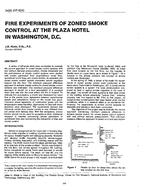Description
A series of full-scale tests were conducted to evaluate the current approach to zoned smoke control systems with and without stairwell pressurisation. Smoke movement and the performance of smoke control systems were studied with smoke generated from unsprinkled wood fires, sprinkled wood fires, and smoke bombs. As expected, the zoned smoke control system prevented smoke migration beyond the fire floor. The minimum pressure difference approach to achieve smoke control for zoned smoke control systems was evaluated. The minimum pressure difference approach is based on a tacit assumption of a constant mass flow rate into the zone where the fire is located. To evaluate this assumption, a model was developed for mass flow in the smoke zone. Agreement between experimental results and calculations based on the model was good. Concerns about expansion of combustion gases and fan temperatures were identified. Approaches to deal with these problems were developed. The experiments showed that chemical smoke from smoke bombs is very different from hot smoke from flaming fires. With few exceptions, smoke bombs should not be used for acceptance tests. Additional research is needed concerning smoke generation of sprinkled fires and concerning the interaction of fires and smoke control.
KEYWORDS: experiment, fire, smoke ventilation, pressurised stairs, performance, wood, zones, calculating, combustion gases, pressure difference, smoke, air flow, flow rate, USA, hotels, case studies.
Citation: ASHRAE Transactions, vol. 96, pt. 2, St. Louis 1990
Product Details
- Published:
- 1990
- Number of Pages:
- 18
- File Size:
- 1 file , 2.2 MB
- Product Code(s):
- D-18676




